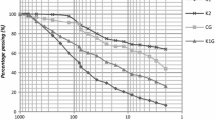Abstract
Tunnel driving in cohesive soil using slurry- or earth pressure balance-tunnel boring machine often encounters serious problems of clogging of parts of the cutting wheel, the excavation chamber or along the cutting handling and discharge systems. This limits mechanised tunnel driving. Clogging is induced by the adhesion of cohesive soils to solid surfaces. In some cases, clogging brings tunnel excavation to a stand-still. The adhesion of soils to solid surfaces depends on capillary forces of the fluid film in the interface between the soil and the solid surface, and can be understood as a boundary layer effect. This fluid film is mostly present due to the water content of the soil itself, or due to the fluid in slurries or earth mud for face supporting. The capillarity forces increase reciprocally with decreasing thickness of the fluid film. The thickness of the fluid film is not static, but is controlled by the soil that adheres to the solid surface. The thickness of the fluid film depends on two soil properties. The first element is the pore water tension (suction) of the soil, which stimulates fluid flow from the interface into the soil matrix. This reduces the fluid volume in the interface, thus the thickness of the fluid film. Pore water tension depends on the mineralogical properties of the clays as well as on saturation. It is a one-dimensional, transient fluid flow in unsaturated conditions. The second element is the permeability of the soil. This paper provides a physical soil model explaining this process. Results of adhesion tests and pore water tension measurements during adhesion tests on adhesive soils supporting the theoretical approach are presented. Permeability test results on unsaturated clays using a permeameter are given.














Similar content being viewed by others
References
Beretitsch S (1992) Kräftespiel im System Schneidwerkzeug-Boden, Forschungsbericht des Institutes für Maschinenwesen im Baubetrieb, Reihe F, Heft 41, Universität Karlsruhe, Karlsruhe
Burbaum U (2009) Adhäsion bindiger Böden an Werkstoffoberflächen von Tunnelvortriebsmaschinen“, Dissertation, Technische Universität Darmstadt, September 2009
DIN 18121: Soil, investigation and testing—water content. Part 1: determination by drying in oven
DIN 18122: Soil Investigation and testing—consistency limits. Part 1: determination of liquid limit and plastic limit, 09/1997
DIN EN ISO 17892-1 (2014): Geotechnical investigation and testing—Laboratory testing of soil. Part 1: Determination of water content (ISO 17892-1:2014); German version EN ISO 17892-1:2014:
Feinendegen M, Spagnoli G, Stanjek H, Neher H, Ernst R, Weh M, Fernandes-Steeger T, Ziegler M, Azzam R (2010) InProTunnel: interfacial processes between mineral and tool surfaces—causes, problems and solutions in mechanical tunnel driving“, Mineral surfaces—from atomic processes to industrial application: Status Seminar 26–27 October 2010, Johannes-Gutenberg-Universität Mainz; programme and abstracts/Schriftl. Ute Münch, Potsdam, Koordinierungsbüro Geotechnologien, 2010, S. 111-125, Geotechnologien science report 16, ISSN 1619-7399
Feinendegen M, Ziegler M, Weh M, Spagnoli G (2011) “Clogging during EPB-tunnelling: occurrence, classification and new manipulation methods”, Proceedings ITA-AITES World Tunnel Congress, Helsinki, 299, pp 767–776
Fountaine ER (1954) Investigations into the mechanism of soil adhesion. J Soil Sci 5(2):251–263
Habenicht G (2006) Kleben, vol 3. Springer, Berlin
Hollmann FS (2014) Bewertung von Boden und Fels auf Verklebungen und Feinkornfreisetzung beim maschinellen Tunnelvortrieb, Dissertation Ruhr-Universität Bochum
Hollmann FS, Thewes M (2013) Assessment method for clay clogging and disintegration of fines in 303 mechanised tunneling. Tunn Undergr Space Technol 37(2013):96–106
Hollmann F, Thewes M, Weh M (2014) Einflüsse von Verklebungen auf die Materialförderung von 305 Schildvortrieben (Influence of Clogging on the Muck Transport in Shield Machines), Tunnel, No. 3, 306 2014, pp 10–19
Khabbazi Basmenj A, Ghafoori M, Cheshomi A, Azandariani YK (2016) Adhesion of clay to metal surfaces; normal and tangential measurement. Geomechanics Eng 10:125–135
Khabbazi Basmenj A, Ghafoori M, Cheshomi A, Azandariani YK (2015) Effect of scale and speed on adhesion assessment in clayey soil. Geotechnical Testing J GTJ-2015-0014 (in press)
Richards LA (1931) Capillary conduction of liquids through porous mediums, Physics, 1, 1931, ZDB-ID 220641-9, pp 318–333, Ithaca NY, Cornell Univ., PhD Thesis, 1931, doi:10.1063/1.1745010
Riek HG (1963) Untersuchungen über die Adhäsion zwischen Boden und festen Werkstoffe, Arbeiten der Landwirtschaftlichen Hochschule Hohenheim, Heft 18. Ulmer, Stuttgart
Sass I, Burbaum U (2008) A method for assessing adhesion of clays to tunnelling machines. Bull Eng Geol Environ 68:27–34. doi:10.1007/s10064-008-0178-6,August
Schlick G (1989) Adhäsion im Boden—Werkzeug—System Forschungsbericht des Institutes für Maschinenwesen im Baubetrieb, Reihe F, Heft 39, Universität Karlsruhe, Karlsruhe
Spagnoli G (2011) Electro-chemo-mechanical manipulations of clays regarding the clogging during EPB-tunnel driving, Mitteilungen zur Ingenieurgeologie und Hydrogeologie; 103, Disseration RWTH Aachen
Spagnoli G, Klitzsch N, Fernández-Steeger T, Feinendegen M, Real Rey A, Stanjek H, Azzam R (2011) Application of electro-osmosis to reduce the adhesion of clay during mechanical tunnel driving. Environ Eng Geosci 17(4):417–426, ISSN 1078-7275
Spagnoli G, Feinendegen M, Fernández-Steeger T (2011) Influence of salt solutions on the undrained shear strength and the clogging of smectite-quartz mixtures, Environ Eng Geosci 17(3):293–305. ISSN: 1078-7275
Spagnoli G, Feinendegen M, Stanjek H, Azzam R (2011) Soil conditioning for clays in EPBMs, Tunnels & Tunnelling International 43 (2011) 10, pp 56–58, ISSN 0041-414X
Thewes M (1999) Adhäsion von Tonböden beim Tunnelvortrieb mit Flüssigkeitsschilden“, Berichte aus Grundbau und Bodenmechanik der Bergischen Universität Gesamthochschule Wuppertal, Fachbereich Bauingenieurwesen, Band 21, Wuppertal. Shaker, Aachen
Thewes M, Burger W (2005) Clogging of TBM drives in clay–identification and mitigation of risks. In: Erdem Y, Solak T (eds) Underground space use. Analysis of the past and lessons for the future, vol 1–2. Taylor & Francis, London, pp 737–742
Zumsteg R (2012) Optimization of clay-polymer-mixtures for soil conditioning, Dissertation, ETH Zürich, Number 20434
Zumsteg R, Puzrin AM (2012) Stickiness and adhesion of conditioned clay pastes. Tunn Undergr Space Technol 31(2012):86–96
Author information
Authors and Affiliations
Corresponding author
Rights and permissions
About this article
Cite this article
Burbaum, U., Sass, I. Physics of adhesion of soils to solid surfaces. Bull Eng Geol Environ 76, 1097–1105 (2017). https://doi.org/10.1007/s10064-016-0875-5
Received:
Accepted:
Published:
Issue Date:
DOI: https://doi.org/10.1007/s10064-016-0875-5




